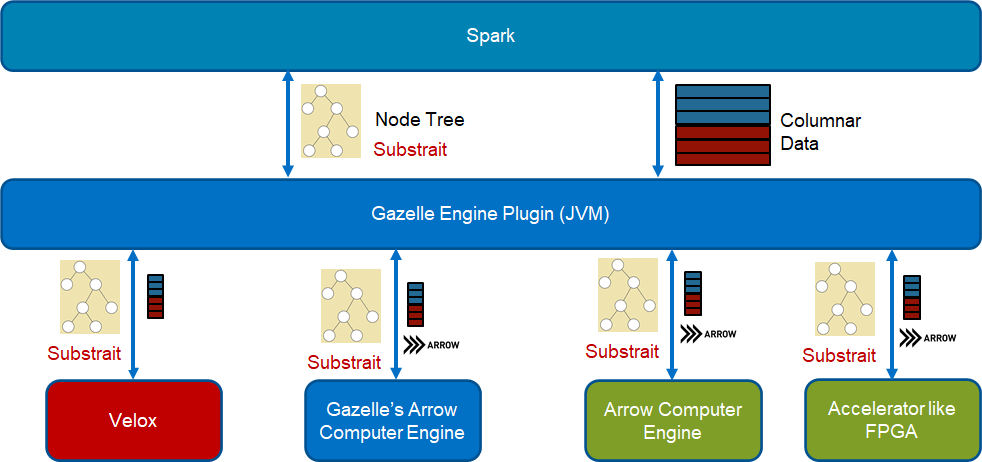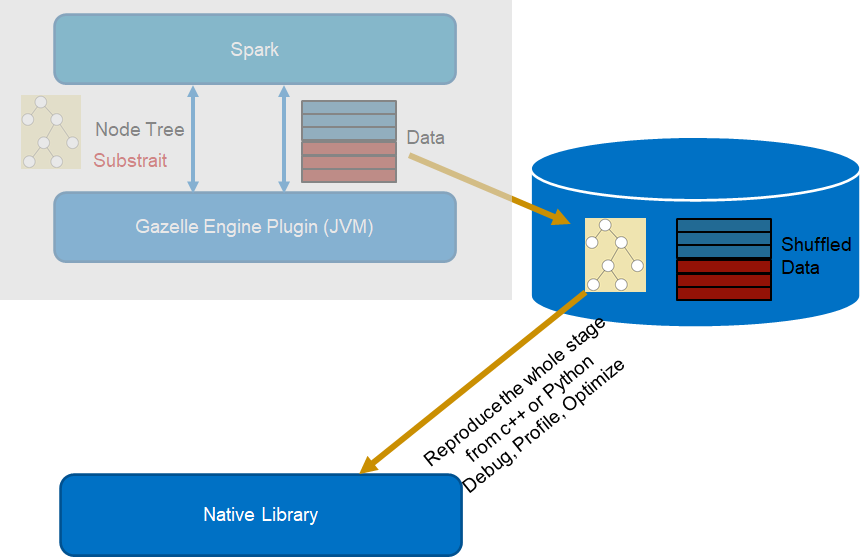* LEGAL NOTICE: Your use of this software and any required dependent software (the "Software Package") is subject to the terms and conditions of the software license agreements for the Software Package, which may also include notices, disclaimers, or license terms for third party or open source software included in or with the Software Package, and your use indicates your acceptance of all such terms. Please refer to the "TPP.txt" or other similarly-named text file included with the Software Package for additional details.
* Optimized Analytics Package for Spark* Platform is under Apache 2.0 (https://www.apache.org/licenses/LICENSE-2.0).
Introduction
This is a derived project from Gazelle-plugin. The JVM code and native code in Gazelle-plugin is tightly coupled. Which make it very hard to utilize other native SQL libraries. The main goal of this project is to decouple Spark JVM and JNI layer from native SQL execution engine. So we can easily enable different native SQL libraries but share all the common JVM code like fallback logic.
The basic rule of the native offloading is that we would reuse spark's whole control flow and as many JVM code as possible but offload the compute intensive data processing part to native code.
The overview chart is like below. Spark physical plan is transformed to substrait plan. Substrait is to create a well defined cross-language specification for data compute operations. More details can be found from https://substrait.io/. Then substrait plan is passed to native through JNI call. In native the operator chain should be built and start to run. We use Spark3.0's columnar API as the data interface, so the native library should return Columnar Batch to Spark. We may need to wrap the columnar batch for each native backend. Gazelle engine's c++ code use Apache Arrow data format as its basic data format, so the returned data to Spark JVM is ArrowColumnarBatch.
There are several native libraries we may offload. Currently we are working on the Gazelle's C++ library and Velox as native backend. Velox is a C++ database acceleration library which provides reusable, extensible, and high-performance data processing components. More details can be found from https://github.com/facebookincubator/velox/. We can also easily use Arrow Computer Engine or any accelerator libraries as backend.
Before we enable Gazelle's C++ code as backend, we will continue Gazelle's development.
One big issue we noted during our Gazelle-plugin development is that we can't easily and exactly reproduce a Spark stage. Once we meet some bugs during Spark run, Gazelle-plugin doesn't dump enough info to reproduce it natively. Mainly because we use very complex extended Gandiva tree to pass the query plan. With well defined substrait and some helper functions, we can easily reproduce the whole stage, which makes debug, profile and optimize the native code much more easier. It also make the accelerators enabling much more easier even without touching Spark code.
Plan Build
To convert Spark's physical plan into Substrait plan, we defined a substrait transformer operator which is a wrapper of the tree of operators to be executed natively. The operator's doTransform function return the final substrait tree. doExecutorColumnar function execute the native node and return columnarBatch. Each operator has its own transformerExec which transforms this operator's plan node into a substrait plan node by transform function. The validate function is designed to check if native library support the operator. The whole process is very like Spark's whole stage code generation flow.
The generated substrait plan can be single operator or a tree of operators depending on if the native library has the support. Once an operator isn't supported in native, we will fallback it to Vanilla Spark. In this way the data should be converted to unsafe row format by Columanr2Row operator. Later if the following operators can be support in native, we can add Row2Columnar operator to convert unsafe row format into native columnar format. The native implementation of the two operators can be much faster than Spark's stock ones. We have implemented them in Gazelle-plugin and will port to here later.
Execution Flow
A simple example of execution flow is as below chart. The transformer operator transforms Spark's physical plan into Substrait. In native the operators are called according to the plan. The last native operator should return an batch which is passed to JVM. We reuse Spark's current shuffle logic but convert data into columnar format. The data split logic should be implemented natively and called by columnar shuffle operator. From Gazelle-plugin's experience the operation is expensive.
Issues to Solve
The code is still not completely cleaned now. The work is still WIP.
Not all the operators and functions are added. Our initial plan is to pass TPCH Q6, Q1 and Q14. Then whole TPCH, then TPCDS.
Operator stat info is pretty useful to understand Spark's execution status. With this design we can only collect info for transform operator which is a combination of operators. We need to find ways to send native operators' stat info to Spark driver.




